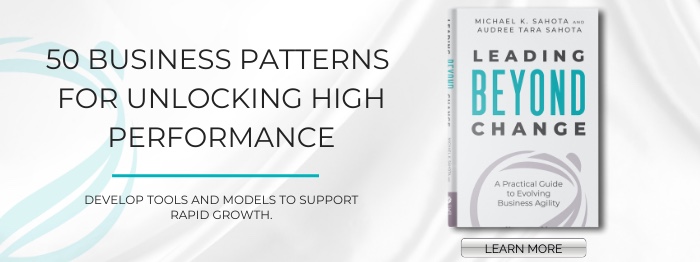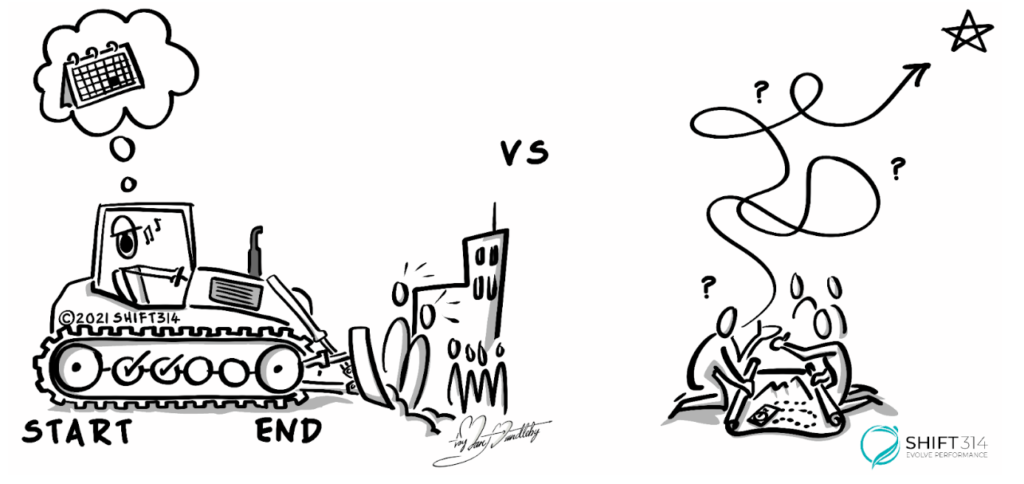Ever wonder how to create a successful organization? All too often, we think of our organizations as static structures. We have fixed change programs to change one specific aspect or dimension of organizational functioning at a time. Yet this approach isn’t rooted in reality.
Organizational survival is optional.
In a rapidly changing world, the
ability to support continuous change
unlocks success.
Adaptability IS the key to success. Organizations that are able to change, recalibrate, and adjust when needed on an ongoing basis will be the most successful.

Successful organizations can withstand crises and grow continually when they:
- Have the internal structures to master the changing world around them
- Have the ability to be financially sustainable based on creating innovative products
- Deliver to clients better, faster and cheaper results
- Build an organization where people are engaged and motivated
- Create an environment where people are treated well, are safe, supportive and build leaders
At SHIFT314, we invite a broader, more penetrating look into what Continuous Change is and what it means to create success in your organization. We also have created the SHIFT314 Evolutionary Leadership Framework™, to help leaders learn how to create an organization that can navigate complexity and adapt to change rapidly. We develop leaders who can lead extraordinary high performance.

A New Perspective on Continuous Change
People often talk about continuous change as if it’s black and white. “Do we have continuous change? Yes or no?”
What we’ve discovered is that Continuous Change is a spectrum. Every organization has a certain rate of evolution. Organizations that go through a more fixed (start-to-finish) change path have a very low rate of evolution. Organizations that move to a continuous change path have a higher rate of evolution which is ongoing.
Why Do Organizations Choose a “Fixed-Change” Path?
The first reason an organization would choose a “fixed-change” path is that it feels safe. They have an A-to-B plan. It seems like it will work and they are sold on certainty. While every executive understands there is no such thing as certainty, they buy the dream.

The second reason is most or all organizations are too busy putting out fires to put their time and attention into continuous change. It seems too messy – no one knows how to do it, and it takes time. No one has time for the future when the present is broken. Yet if there had been balance between Production and Production Capability, the functioning of the organization would be smoother and able to ride the waves of uncertainty and rapid change.
We can see a rate of the evolution towards high performance is needed for survival, and we understand there is no end to this. The Continuous Change approach begins with asking, “What is our rate of evolution? Low, medium, high, or very high?”
When we start to look at the broader picture, that’s what we call the Rate of Evolution. The higher it is, the better. The greater our rate of evolution, the greater our adaptability and ability to thrive and surf the waves of change. High-performing organizations have a high rate of evolution.
Organizational Survival is Optional
When your organization stops looking at how to evolve into an incredible organization, it will loose the game of survival. Yet, it is no longer about the bottom line – survival includes the people that are a part of your organization, because you ship your team.

An incredible organization is created by the people who work within the organization, and they are a key factor in organizational success. Our motto is “Scaling Excellence With People.” Your people are your organization, they will pull your sustainability up or down.
Discontinuous Change vs. Continuous Change
Discontinuous change occurs in response to an abrupt event in the environment – a strategic shock – for which there is no organizational precedent. Discontinuous means the event is not continuous with the past or current direction of the organization.
Organizations that have a very low rate of change cannot survive a shock or a rapid shift in the business world. These could take the form of economic, environmental, delivery breaks or malfunctions. The stress and chaos of having to quickly change processes or structures sends a shock wave through the organization. People no longer have the ability to function or use their intelligence to solve cruscial problems that need immediate attention.
Finite and fixed change approaches are for specific outcomes.They do not include the ability to ride the shock waves of discontinuous change. Organizations that have a high rate of evolution with continuous change have the ability to ride the shock waves, surfing like professionals to achieve high performances no matter what happens.

Discontinuous change can also be a positive need for the organization to flourish, yet it can still create a destabilization of the work environment. Transitions are challenging, even when they are positive.
Responding to Change
A workforce that has what we call an “Evolutionary Mindset” can function in uncertainty and sustain capability throughout a shock wave. This type of organization works continually on high performance by learning. Continuous reflection, “Is this the best it could be? How can it be improved to create greater success now and in the future?”
Every day this mindset integrates change and evolution to make the work environment, delivery, and products better. Organizations get better over time through many points of innovation that stimulate movement towards a better future.
Why Change Initiatives Fail
Most organizations are stuck in a mechanical, “Traditional” paradigm of how things function. This is also known as “business as usual”. Leadership prescribes changes to the structure, with the hope it will lead to a change in the organizational system and how it performs. Yet this approach will not change the rate of evolution.

What can a leader do to unlock success? Take a people-centric approach. When we increase the rate of evolution of each person, we create an organization where evolution is happening all the time. Remember, you ship your team.
Your role as a leader is to develop your people so they can perform better. As a leader, you have the ability to impact and grow your people.
Some Things to Think About:
- How do people see themselves in their job or role and in the workplace?
- Is there enough psychological safety to navigate uncertainty and rapid change?
- How do your people interact with each other? Do they collaborate?
- Does everyone celebrate the brilliance in others? Do you?
- Is everyone focused and motivated to elevate the organization’s level of functioning?
- What is the rate of evolution in your organization? Do you have continuous improvement?

Evolutionary Mindset
At SHIFT314, we realize that an Evolutionary Mindset is required for Continuous improvement and high performance. An Evolutionary Mindset is a mindset in which leaders are evolving themselves. Then, they can inspire the broader population of the organization to evolve as well. We have evolved Carol Dweck’s “growth mindset,” to an “evolutionary mindset” (continuous improvement!). This is what Evolutionary Leadership is:
The choice to evolve oneself and develop the capabilities
needed to evolve an organization. This requires an Evolutionary Mindset.
The key essential ingredient to leading an organization that is ready to evolve is a leader saying, “I’m ready to evolve.” Once that choice is made, effort can be focused on building greater evolutionary capabilities to accelerate the rate of change. With increasing your personal rate of evolution, you increase the rate of evolution within the organization.
Leadership is the Foundation of Continuous Change
Continuous Change is measured by the rate of evolution of an organization. This in turn is measured through the rate of evolution of individuals – specifically, leaders who can inspire and develop their teams and the organization to high performance no matter the volatility of the environment or any Discontinuous Change.

Organizations can survive the uncertainty and complexity of today’s ever-changing world by working on continuous change. Here’s how:
- Understanding the Value and Importance of Production Capability
- Developing the Ability to Navigate Discontinuous Change
- Developing the Ability to Learn, Grow and Evolve
- Creating an Environment Where the Brilliance of the People is Developed and Celebrated
The essence of creating continuous improvement is to create a high rate of evolution: scaling excellence with people. However, leaders aren’t the only ones who can support this evolution. Any person in the organization can start evolving themselves and their part of the organizational system. Change isn’t someone else’s job: it’s everyone’s job.



